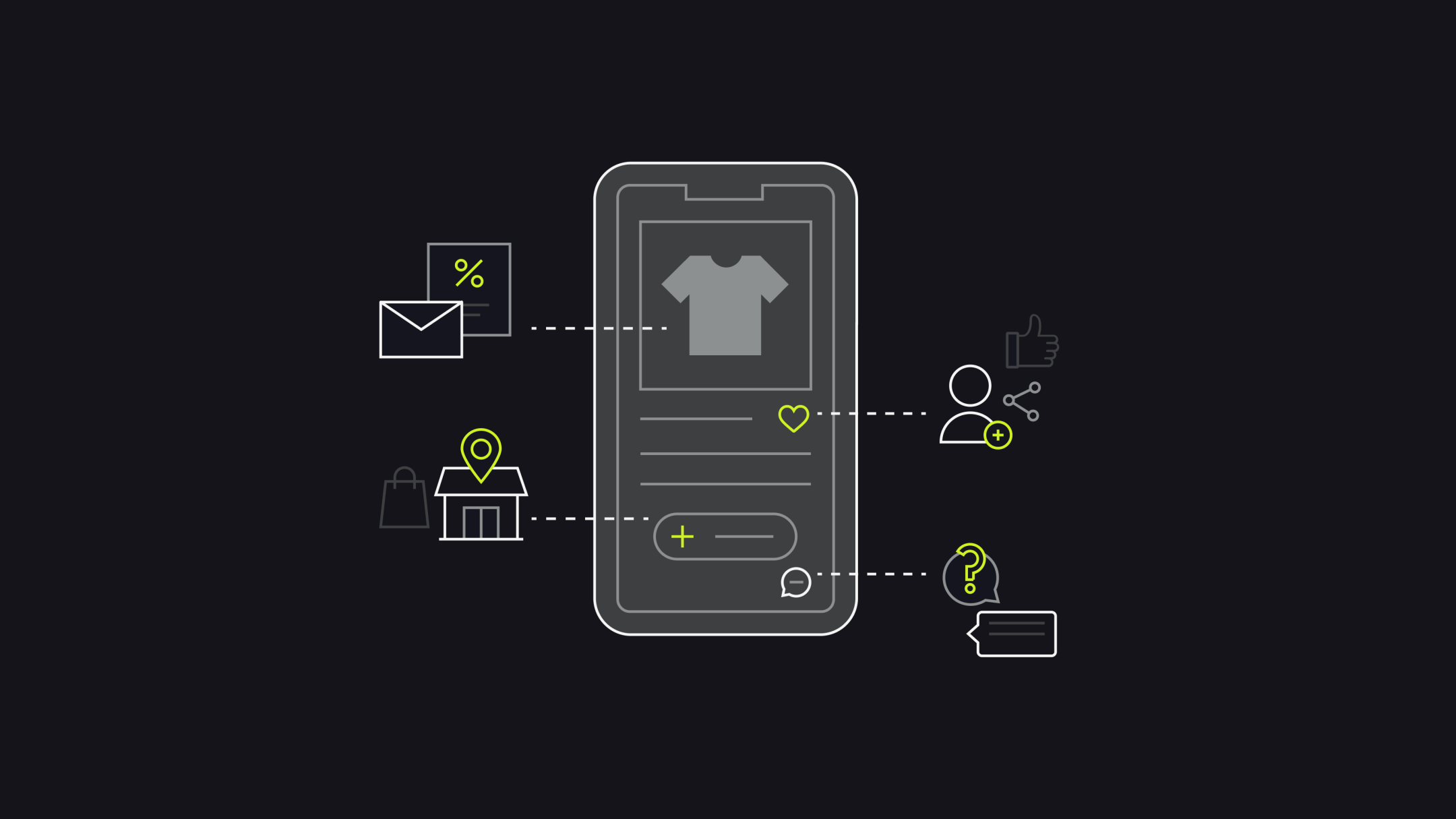Your customers want to be able to shop on their own terms: when, where, and how they wish. They want access to their shopping cart on any channel or device, and even in-store.
They want to “start anywhere and finish anywhere,”one reportrevealed.
Amulti-channel strategyisn’t enough to match this need, as it creates separate, independent shopping ecosystems. You need an omnichannel approach to your marketing, sales, and customer support for a connected, friction-free customer experience.
This guide will take you through everything you need for creating exceptional omnichannel customer experiences: benefits, action steps, as well as some examples of brands with exceptional omnichannel experiences to inspire you.
- What are omnichannel customer experiences?
- Why should brands and retailers care about omnichannel customer experiences
- Omnichannel客户体验的最佳实践
- Examples of brands and retailers defining omnichannel customer experiences
- Take your next omnichannel experience step
What are omnichannel customer experiences?
An omnichannel retail experience can incorporate several channels, like online platforms, brick-and-mortar, and apps. For example, a clothing boutique sells products through their online store, Instagram, and in person.
True omnichannel experience isn’t about adding a Buy button to as many channels as you can. It’s a singular, cohesive buying journey across the channels your customers use.
With it, they can research, purchase, get support for a product, and buy again across dozens of touchpoints, without boundaries or hiccups.
Omnichannel breaks the silos between in-store, social media, mobile, email, web, phone, and live chat experiences you give your shoppers.
An omnichannel experience might look like this for a customer buying at-home gym equipment:
- A customer searches for workout mats and weights and looks at a few products on a website, but leaves without buying.
- They see an Instagram ad from the same brand for a discount code for weights. They sign up for the code, but don’t buy right away.
- They start seeing ads for those same weights on YouTube and Facebook.
- They return to the site a week later, add weights to their cart, but don’t make a purchase.
- Within days, they get a cart abandonment email. Instead of just reminding them about the products in the cart, the email shares multiple ways to order: shipping to their home, buying online and picking up in-store, buying in-store and shipping to customer.
- The customer sees a billboard for the brand while driving and decides to stop by, browse the weights in-store, and order shipping to their home.
Here’s what the exact opposite experience looks likeas described by Sean Downey, VP of media platforms at Google:
- Every year, Downey buys his son the latest video game for his birthday, always from the same company.
- This company didn’t store any of Downey’s previous purchases. This made the checkout slow, but acceptable.
- He received an online ad the next day for the exact game he purchased. The ad offered a discount, even though he just bought it at full price.
This is amongthe most frustrating types of interactionconsumers experience—more frustrating than receiving an irrelevant offer.
Omnichannel gives each brand an opportunity to build relationships with customers. But omnichannel isn’t explicit or obvious. It’s not something you wrap nicely with a bow on top and hand over to the customer.
It’s invisible, present in every interaction, and built to make your customer’s life easier.
In the words and drawings ofMarketoonist:

Why should brands and retailers care about omnichannel customer experiences?
Here’s what makes omnichannel experiences worth your focus.
Consumers want unified, personalized experiences
A total of 63% of consumersexpect personalized interactionsand offers based on their past purchases.
The majority of consumers—91%— willchoose brands who recognize,remember, and provide relevant offers and recommendations. They’re also happy to share their data to enable a personalized experience.
It’s not just about past purchases, either. Shopperswant a single cartthey can access on their phone, computer, or even in-store.
Omnichannel drives the bottom line
Brands that offer a unified shopping experience win over those that stick to one channel.
Omnichannel shoppers have a30% higher lifetime valuethan those who only shop on one channel.Omnichannel marketingalsoincreasesengagement rate, purchase frequency, average order value (AOV), and customer retention rates.
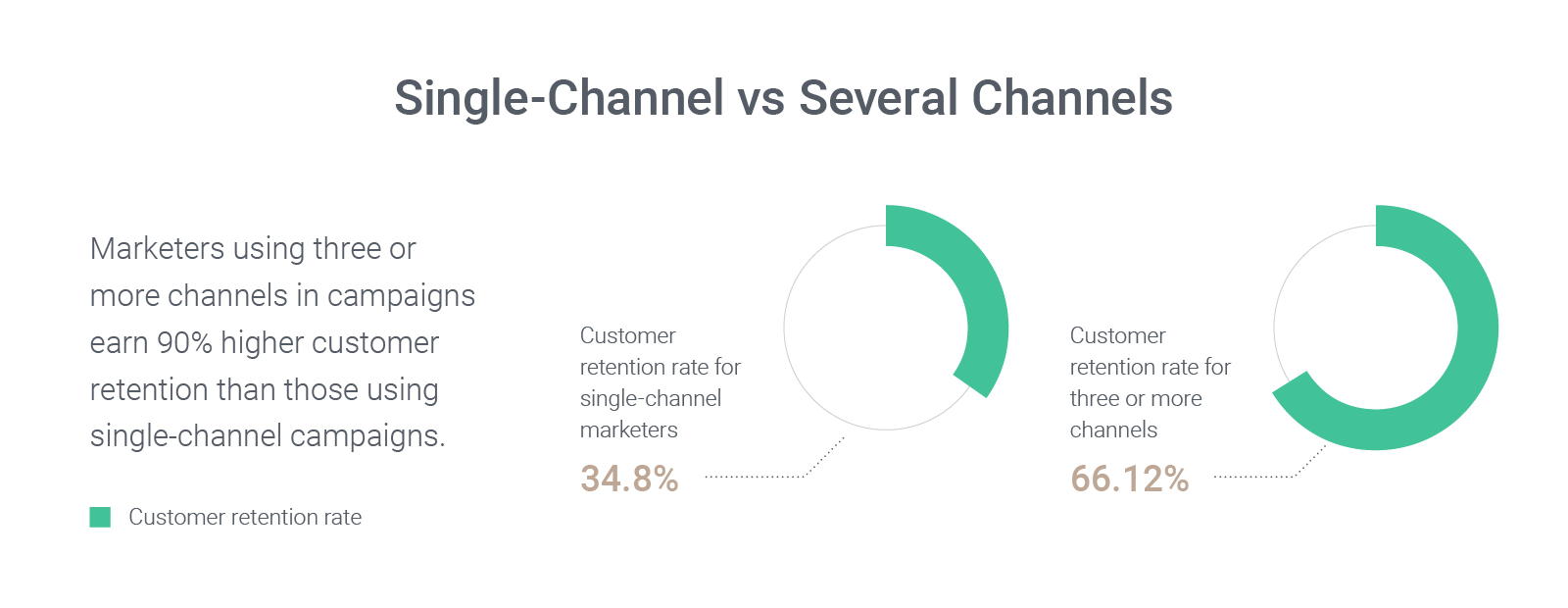
Shoppers are40% more likelyto spend more than planned when the shopping experience is highly personalized. They alsospend more in-storeif they research their purchase online before their visit. The more channels they use, the more they spend in the store.
Nearly half of shoppers have purchased a productthey didn’t intend to buy, thanks to a personalized recommendation from the brand. Seamless customer experiences infuse trust into every touchpoint, not just when the customer is in shopping mode.
The experience doesn’t stop after the purchase
Thecustomer journeydoesn’t start with research and end with a completed checkout. The purchase marks the end of just three out of five layers of the journey:
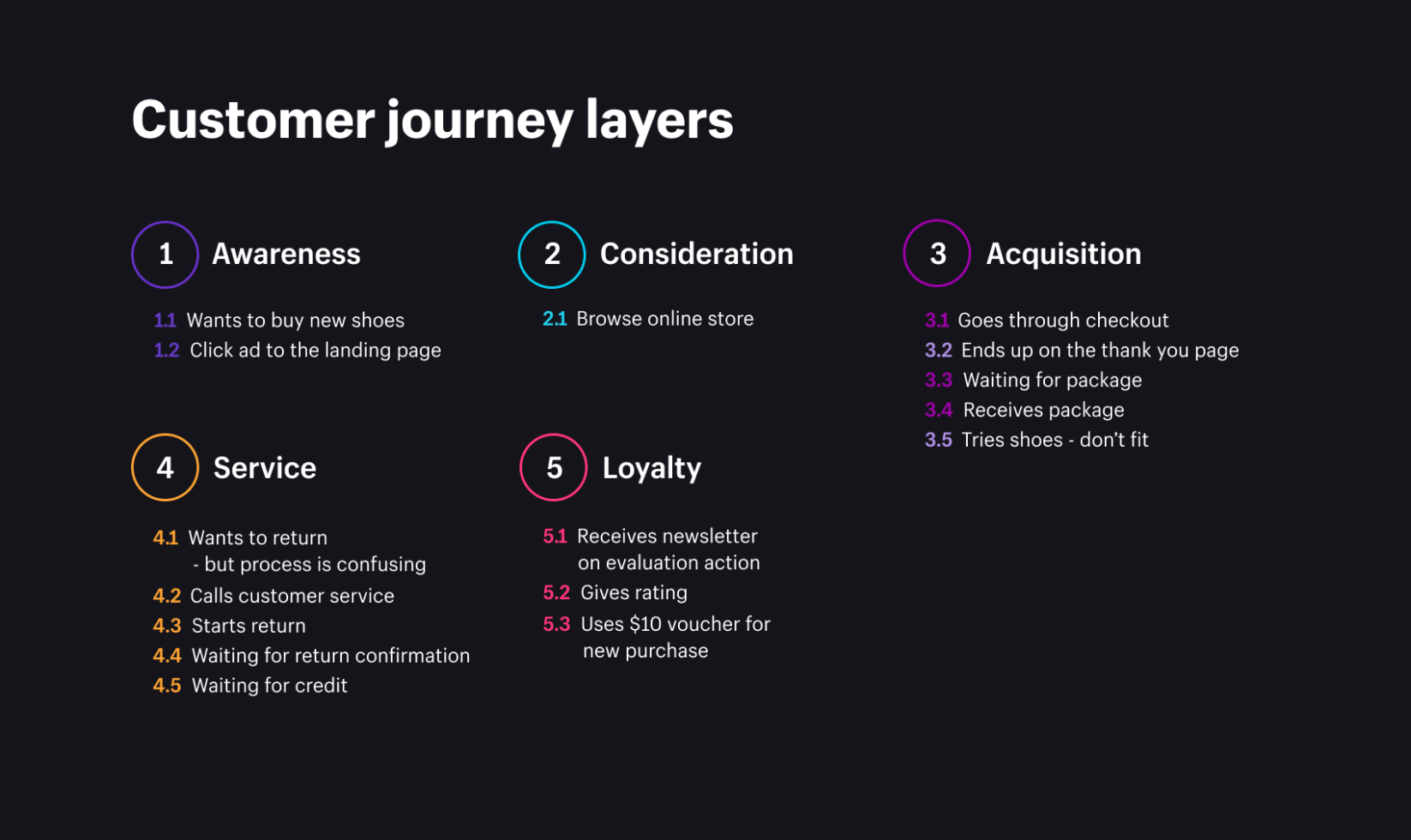
Returns, refunds, exchanges, customer service interactions, and ratings are all part of the experience. It makes customer service a key omnichannel building block.
According to Gladly,76% of customersexpect agents to see interactions across multiple platforms. There’s more: two-thirds of consumers wish agents on the phone or digital channels knew about previous interactions in the store and vice versa.
Only 19% of customers receive aseamless consumer experiencebetween platforms. It’s an opportunity for brands to stand out through omnichannel customer support.
The year 2020 changed the way we shop forever
The COVID-19 pandemic saw the equivalent of 10 years of ecommerce growth happen injust three months。

Nearly150 million peopleshopped online for the first time during the pandemic. Consumers started buying items online they otherwise bought in-store: groceries, home essentials, and hygiene products.
Many brands started offering new fulfillment options, like reserving for store pickup. Almost a third of buyersused curbside pickupfor the first time between March and June 2020.
This led tonearly 100,000 brandsworldwide beginning to offer curbside pickup during the pandemic. The safety, convenience, and savings of these new options are appealing. Other strategies similar to buy online, pickup in-store (BOPIS) include:
- Buy in-store, ship to customer
- Buy online, return in-store
- 储备online, pickup in-store
- Online returns or exchanges
This isn’t just a trend—the way customers shop has changed forever. Click-and-collect salesmore than doubledin the United States in 2020. This double-digit growth is predicted to grow through 2024.
“If you’re waiting for this to end, you say we’re gonna be back to normal in two months, that we’re just biding our time and getting through it, then you’re gonna be screwed,” says Jill Manoff,Glossy’s editor-in-chief.
Omnichannel experiences allow your customers to buy, try, and return products on their own terms. If you don’t let them have that, someone else will.
Omnichannel客户体验的最佳实践
The most successful omnichannel retailers and brands use these best practices:
- Know the customer journey inside out
- Build channel-specific content and options
- Provide seamless customer service
- Maintain consistent branding and messaging
- Use resilient omnichannel inventory management
1. Know the customer journey inside out
Dig into all the data you can get your hands on. This will help you understand what your customers want, where they want it, and how.
Where are customers looking for products like yours? What keeps their attention? What makes them click through to the next resource? Where do they drop off or need more help?
Here’s where to look for key data:
- YourGoogle Analytics。Reports like Behavior > Behavior Flow and Conversions > Goals > Reverse Goal Path will show you where customers leave and which pages lead them to important touchpoints like their cart or the checkout page.
- Data from other platforms.看看人们点击你的邮件,什么questions they ask about on social media, what they send you messages about, and what content engages them the most.
- Advertising data.When you run ad campaigns on Facebook and Google, you unlock rich audience data and learn who is searching for your products, and how.
“User bases are fragmented and purchase journeys are longer, so being active on multiple advertising channels is crucial,” says Josh Brisco, VP of growth media atTinuiti。
The first step is to identify who your customers are, where and how they spend time online, and how they shop. Then, run ads to experiment with potential channels that match this, and further unpack insights that answer those questions. This will inform your media strategy with these channels and help you expand to new ones over time.
One study shows that92% of consumersvisiting your website aren’t there to buy, so use every touchpoint to understand their complete journey beyond your site.
2. Build channel-specific content and options
How can you help the customer there and then with the exact piece of information or next step they need?
Add resources, tips, and checkout options in places customers crave that next step. This will create a frictionless experience, even if it includes switching channels.
For example, you could add a video with care tips to your product page, likeMy City Plants, so customers don’t have to look for this reassurance elsewhere:

另ther option is adding a fit calculator or a similar custom resource.ASOSoffers a Fit Assistant tool that remembers your result on the device you took the quiz on; it then shows you the best size recommendation, even when you browse other products (like after clicking on a link in an email or on social media), and even when you’re not logged in:
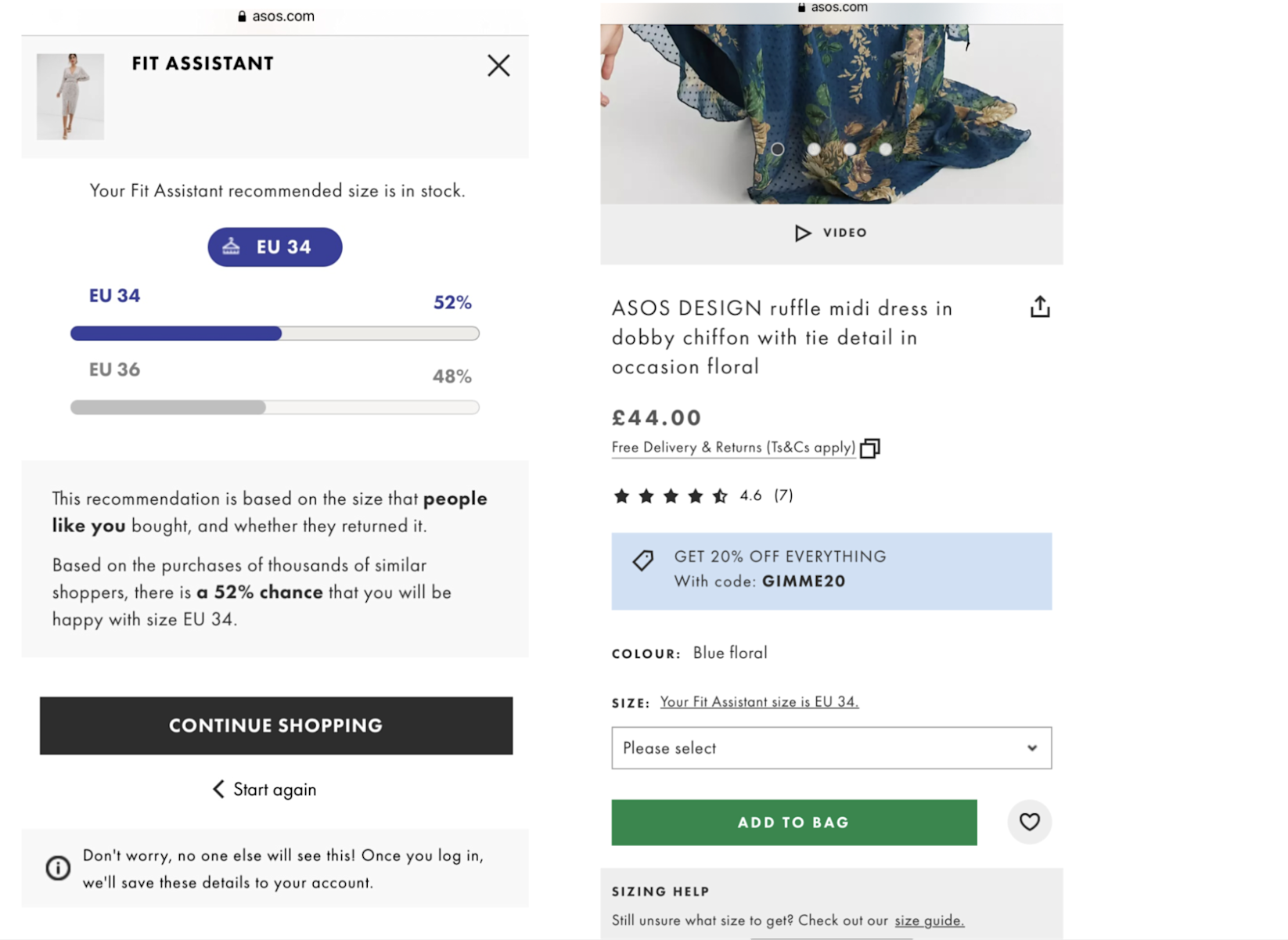
L’Oreal Paris knows choosing a hair color is hard, so when its hair experts answered questions about this on Instagram Stories, they also linked to their handyvirtual try-on page:
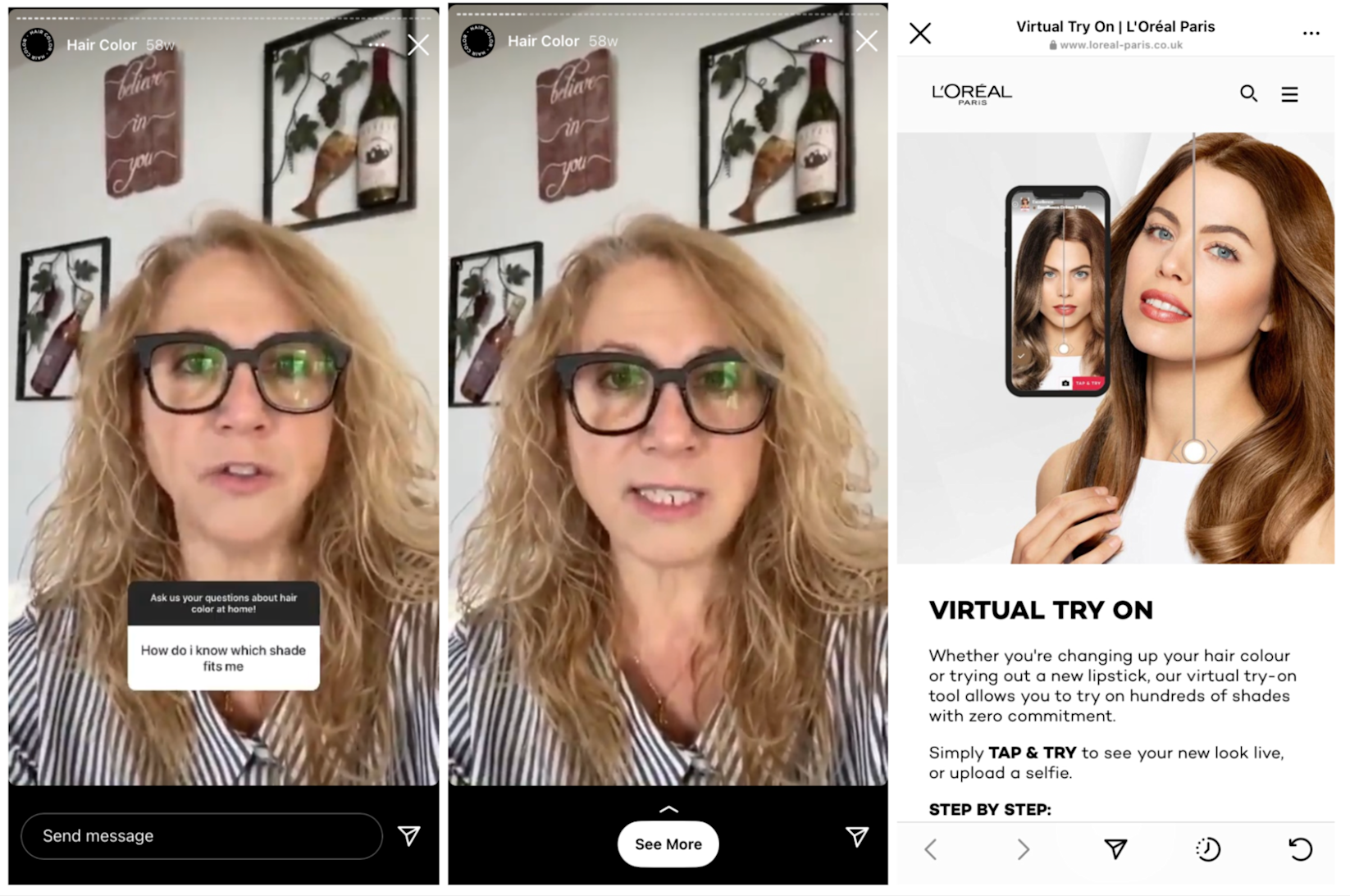
AndBenefit Cosmeticsuses Instagram Stories for in-depth tutorials that feature a product tag, which leads to its website with a smooth checkout experience:
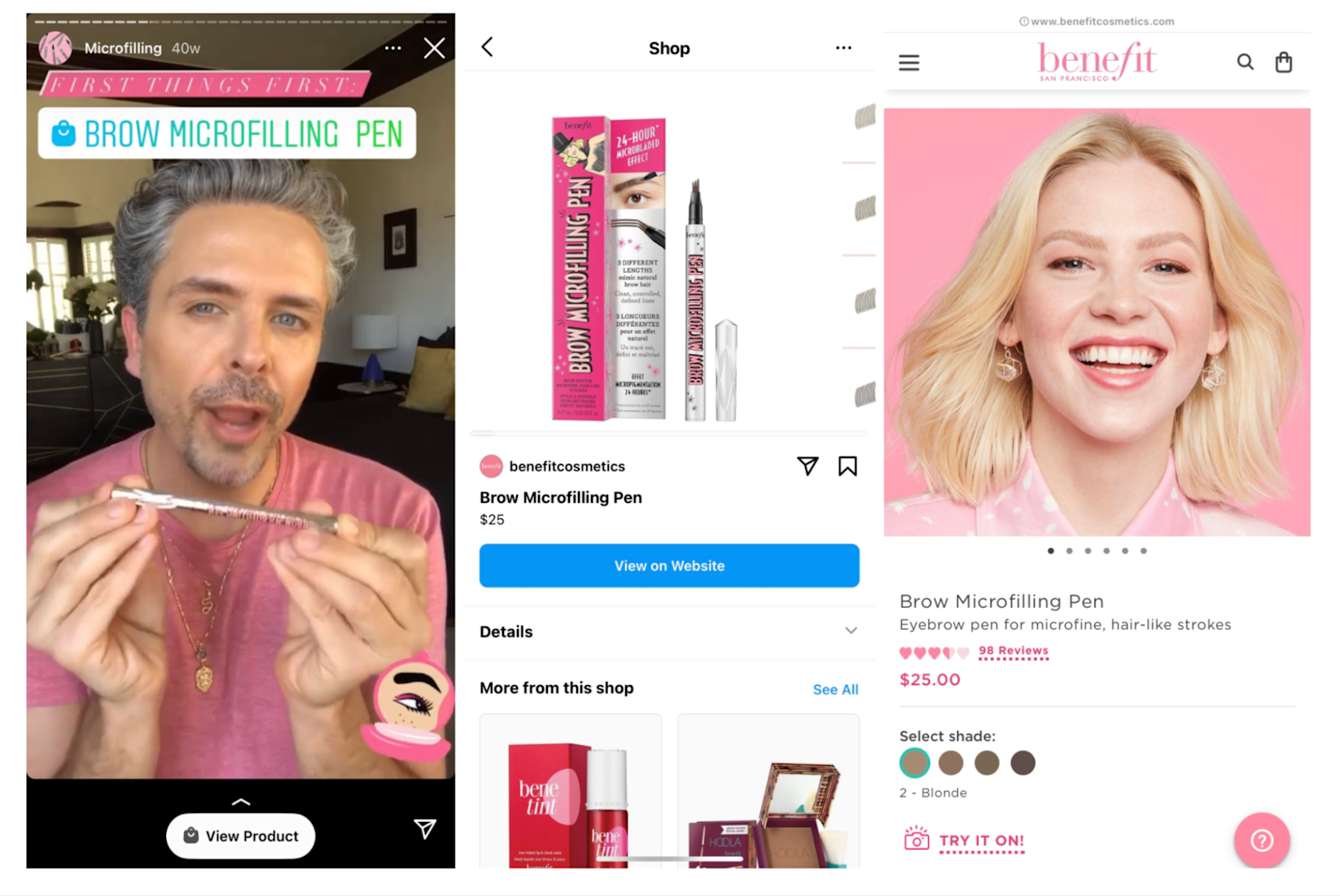
3. Provide seamless customer service
Consumershave spoken: 86% of them expect conversations with customer service agents to seamlessly move between channels, and 84% of them spend more with brands that make this happen.
Buyers expect you to support them well while their attention spills between channels. Siloed customer support channels stand in the way of omnichannel customer experiences.
This can turn into a frustrating experience that looks like this:
- A customer tweets you about an issue with a recent order.
- You reply with a prompt to send you a direct message on Twitter.
- The customer messages you, but doesn’t hear back for a couple of hours.
- While they wait, the customer reaches out to you through live chat on your site.
- An agent responds over live chat, but prompts the customer to call customer support.
- The customer calls, but when they reach someone, they have to describe their issue again as the agent on the phone has no record of prior interactions with the customer.
There’s a better way: a solution that brings all customer touchpoints together. It builds a single customer view with a complete profile of purchases, lifetime value, personal preferences, and past interactions.
One reportfoundthat limited cross-department collaboration and siloedcustomer datapresent the biggest customer experience challenge:
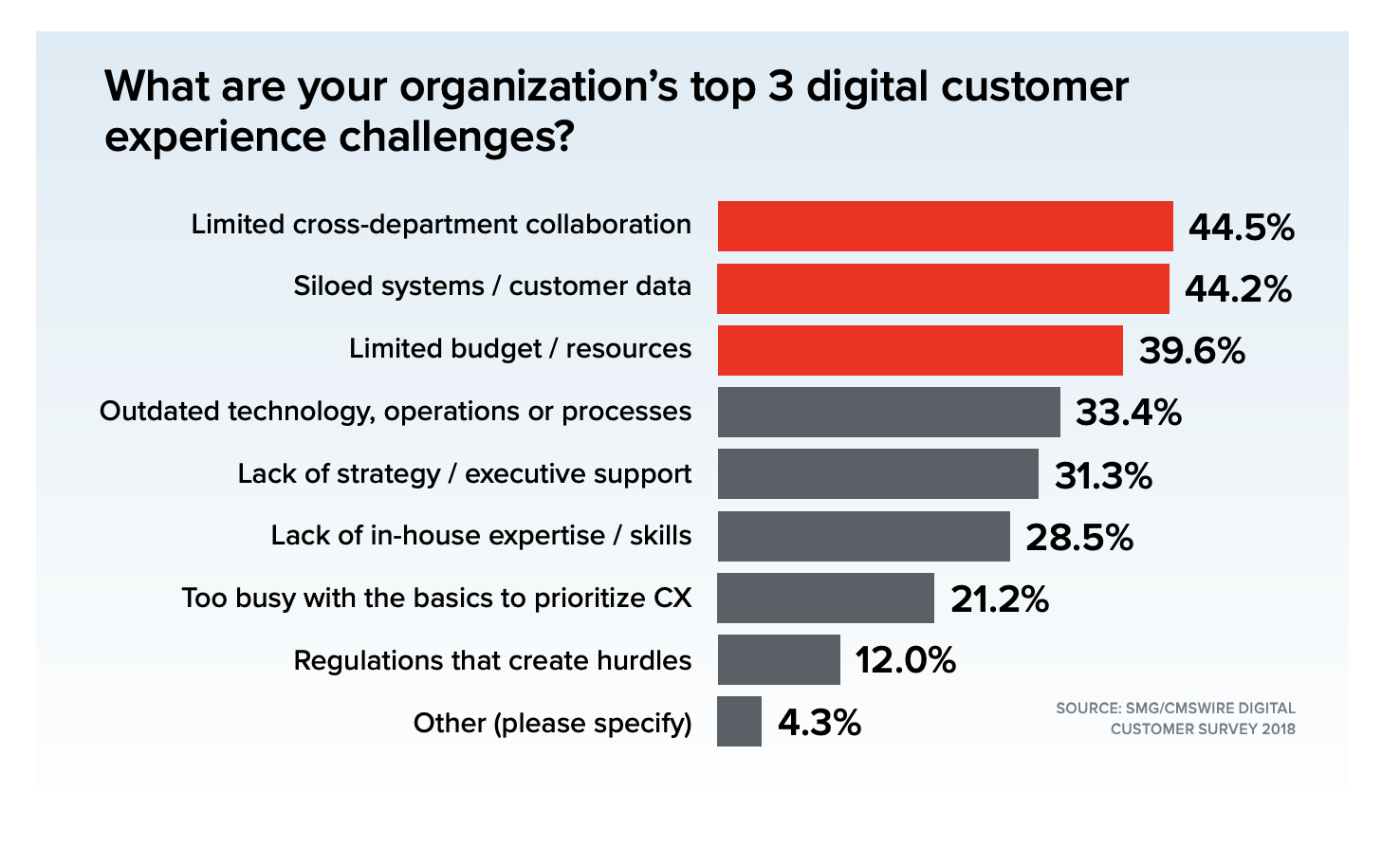
An omnichannel customer service platform likeGladlyallows you to focus on people instead of tickets and support your customers wherever they need you to.
4. Maintain consistent branding and messaging
Make it easy for customers to recognize you and trust you regardless of the channel they’re on. Consistent visuals, voice, and style between touchpoints is key.
“Your message across platforms needs to be cohesive. Not just your branding, but also your tone, and your offers should align no matter where you’re marketing or talking to your customers. This is a massive trust factor for your audience,” says Darcy Ogdon-Nolan, founder ofThe Bircher Bar, a high-end resource for food, lifestyle, and wellness.
Consistent branding canincrease revenue by 33%, but 81% of companies still deal with off-brand content.
Build a brand style guide to help all your employees stay consistent, no matter the channel or format. Your brand guidelines can include:
- Voice: a reflection of who you are as a company
- Tone: examples of adapted voice to different situations (customer support, social media posts, etc.)
- Grammar and mechanics: capitalization, punctuation, spelling, formatting
- Naming: rules for using your brand, category, and product names
- Color palette and instructions for using it
- Typography: fonts and sizes for different use cases
- Photography: directions for product and promotional photography for website, social media, emails
- Illustrations and icons
This will create a strong impression on every channel where your customers interact with you.
5. Use resilient omnichannel inventory management
Seamless marketing and customer service across channels isn’t enough. There’s another essential piece of the omnichannel experience puzzle:inventory management。
这些checkouts-on社会我你的库存水平dia, your mobile app, brick-and-mortar, website, live chat, and anywhere your customers shop—need to match instantly.
If they don’t, here’s a reminder of what happened during thePlayStation 5 2020年发射, when customers:
- Ended up in long digital queues
- Got technical error messages
- Received order cancellations just hours after ordering
- Waited for their console for months instead of weeks
One UK customertweeted: “Great job @PlayStationUK letting these unreliable retailers sell them online. Absolutely ridiculous. I don’t think a single person in the UK has got a PS5 today!”
Ouch.
Omnichannel inventory managementis a challenge because of segmented supply chain processes, poor stock management, and fragmented returns logistics. Almosttwo-thirds of shoppersare more likely to shop online if they can return an item in-store, but this omnichannel benefit is also a liability when it comes to stock levels.
Be prepared for everything with solutions likeShopify Plus POSto manage your in-store and online orders, inventory, and customer data in one place. Also check outecommerce automationfor automating inventory management and updates across channels.
Examples of brands and retailers defining omnichannel customer experiences
Get inspired by these omnichannel brands and retailers:
- BonLook
- Rothy’s
- Sweetwater
- ILIA Beauty
- Cocomelody
BonLook
BonLooksells prescription eyeglasses and sunglasses in stores across Canada and worldwide online.
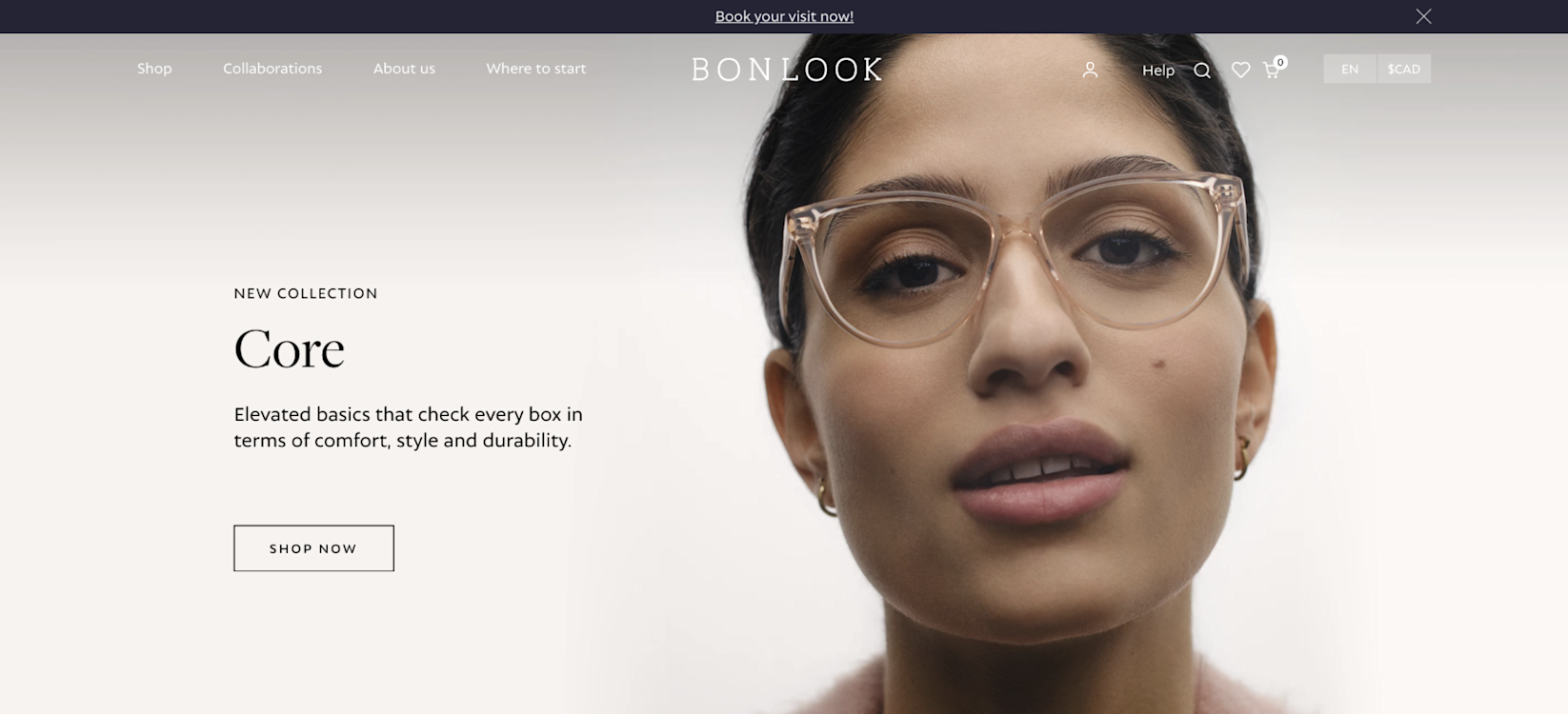
Shopping for glasses is a high-touch, unique buying process, including lens materials, prescriptions, frame types and sizes, styles, and additional lens features. It naturally lends itself to brick-and-mortar shopping.
To replicate this in-store experience for online customers, BonLook launchedshopping guidesas well as a virtual try-on feature. It gives customers a 180-degree view of how glasses will fit them.
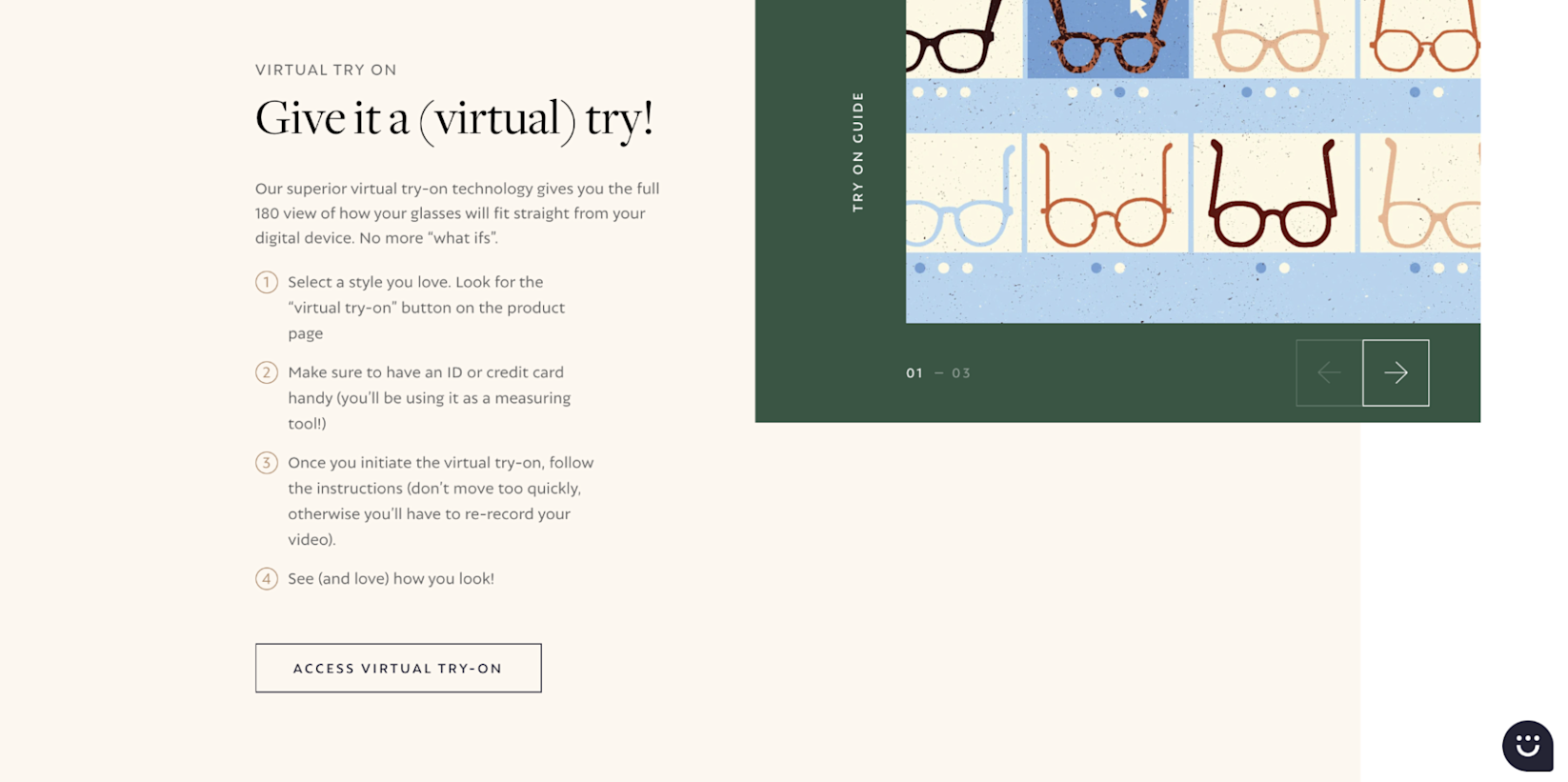
It also offersa custom iOS app that allows associates to help customers decide on frames and then make their purchase. The app integrates with the online store, so customers can purchase that way if they want. In-store associates can see inventory and orders in real time.
BonLookruns this integrated omnichannel strategy on Shopify Plus. Since switching from its previous solution, it has increased its average order value by 18%. As many as 15% of shoppers buy again within six months.
Rothy’s
Rothy’ssells comfortable everyday shoes made from recycled materials. Its omnichannel strategy focuses on unified customer support and a sustainable returns and exchange process.
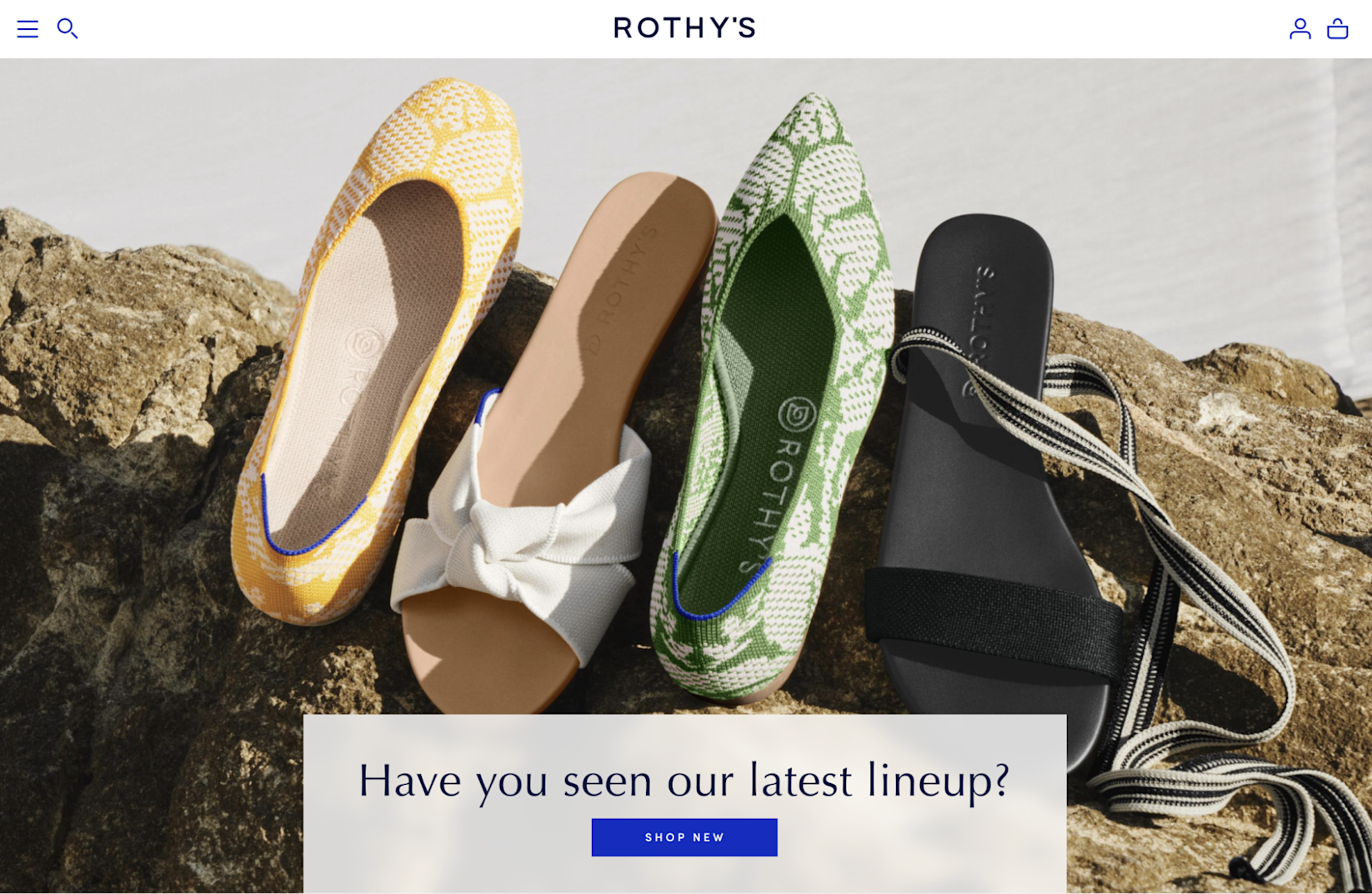
First, Rothy’s wanted to bring all its customer conversations to a single platform. The goal was to avoid making customers repeat their issues to different agents, regardless of the channel.
All customer conversations were stored as individual tickets before they started usingGladly for customer support。如果客户邮件进来,代理没有看到previous chat conversations or phone calls. Customer service was slow, and customers had to fill in the gaps each time.
With a single conversation timeline, agents now see the entire customer history. Customers can get help on any channel they want without sacrificing the quality of the answer they’ll get.
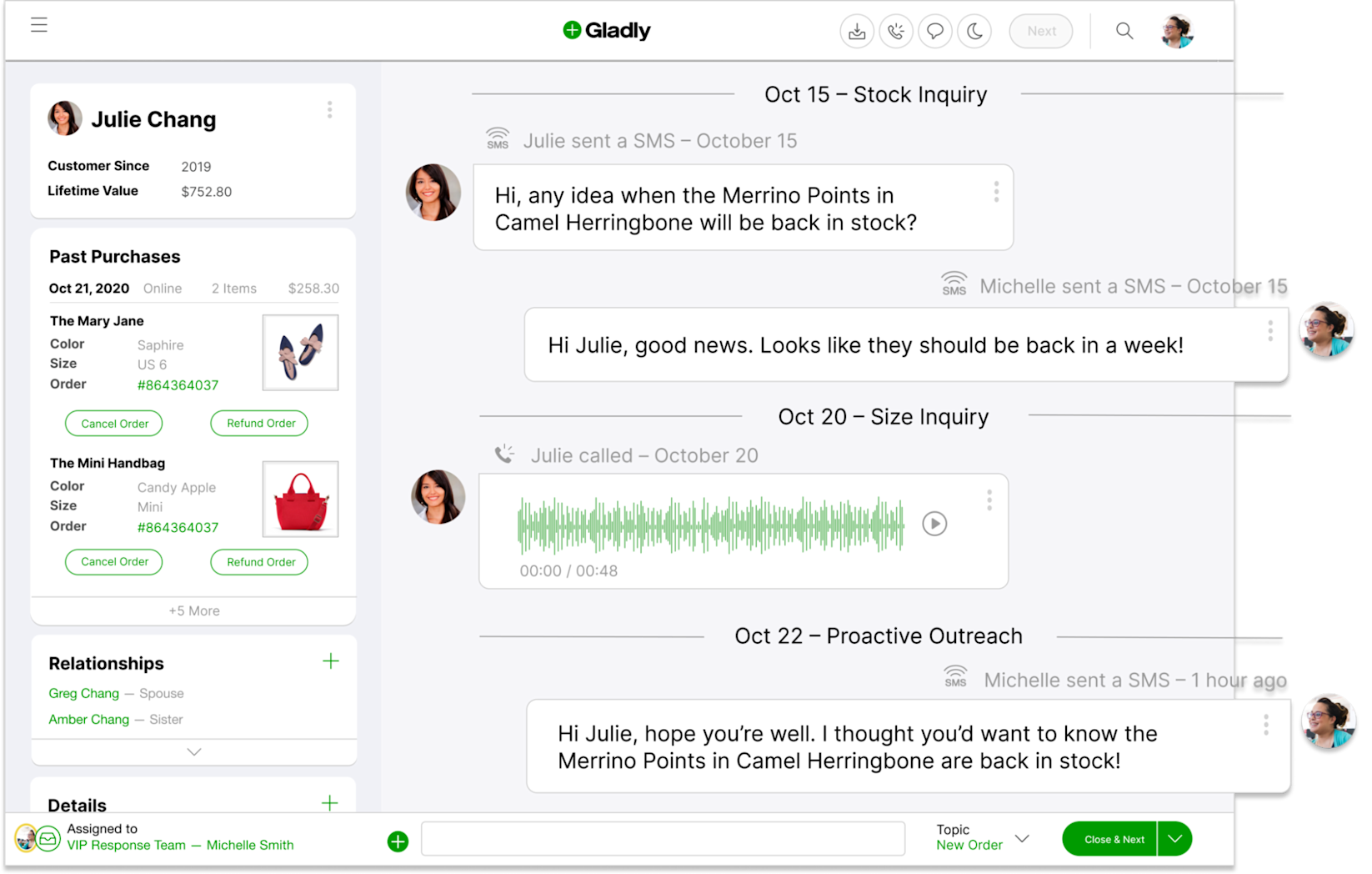
A customer doesn’t even need to have their order number handy—Gladly pulls customer’s orders from Shopify into their profile on Gladly for a true 360-degree customer view.
“We want to give them the channel of their choice. We also wanted to leverage our website. We wanted to make sure that we were putting information that's usable, that we could embed chat capabilities, where they can talk to somebody, but also that we can direct it and predict what questions they might have,” Nic Cadwallader, director of customer experience at Rothy’s,told CGT。
Second, when Rothy’s opened its first physical location in 2018, it realized it needed to improve its returns process. In-store returns weren’t sustainable, as they createdlong lines around the block。
The brand’s customers value sustainability, and returns by mail in cardboard boxes weren’t ideal. Rothy’s implemented aReturns Bar solutionand took advantage of an existing returns infrastructure. This encouraged in-person returns without a strain on the physical store.
It gave customers the option to shop and return the way they want, on a channel they want, and that aligned with their values.
Sweetwater
Sweetwatersells musical instruments and pro audio equipment in itsFort Wayne storeas well as online. It served over 1.5 million customers in 2020, crossing$1 billion in revenue。
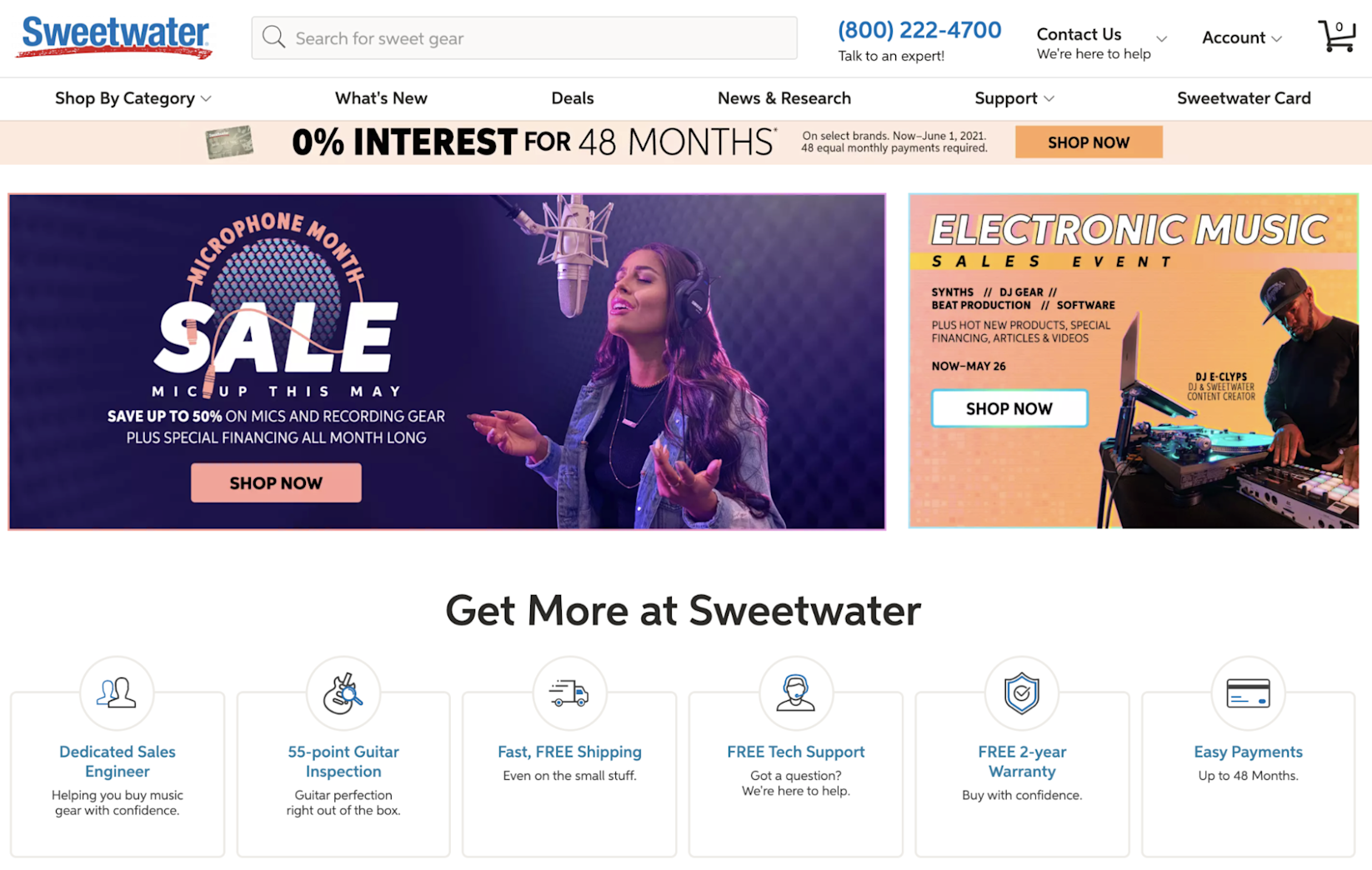
Its retail location features massive guitar galleries, a drum room, and fully loaded demo studios. Sweetwater’s expert staff is there to help—a dream come true for a music gear buyer.
So what about shopping online? Sweetwater’s omnichannel strategy helps recreate the in-store experience.
Sweetwater’s category pages feature buying guides for the category you’re viewing at the top:
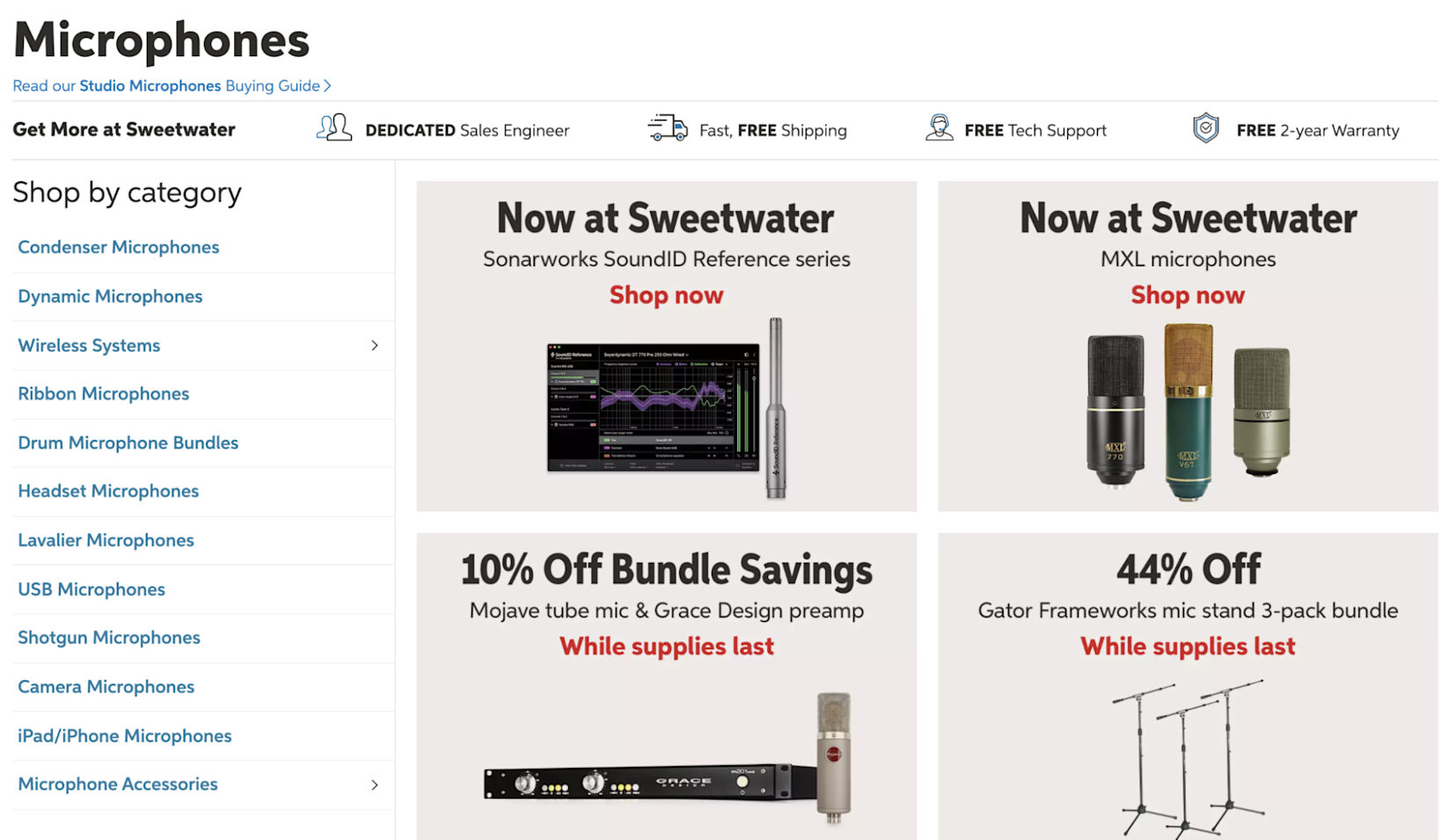
As you browse categories and products, the top bar and the bottom right corner remind you to ask for help through phone or email, if you need it:
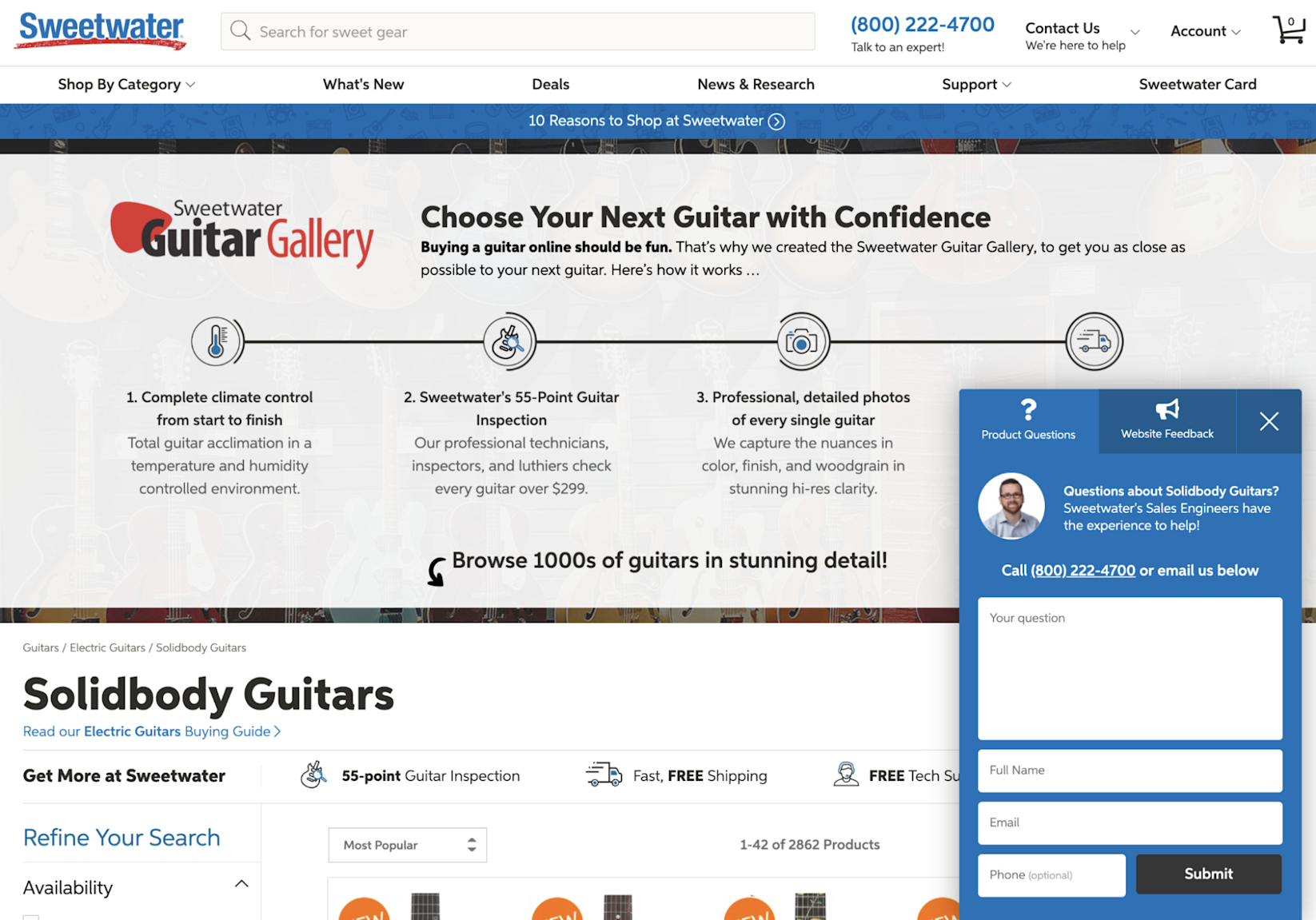
The real magic happens as you get deeper into your buying journey. Sweetwater embodies the seamless omnichannel approach to customer experience and assigns each customer a sales engineer.
These sales engineers learn about the customer’s style, setup, and ambitions, and help them choose the best option. Even before they make a purchase, shoppers can quote their cart ID so agents can instantly see what they’re shopping for:

“It's never about a sale, it's about providing the best experience possible during every interaction. Our sales engineers spend 13 weeks in training before they’re able to interact with customers. That commitment to making sure our employees have the tools they need is uncommon within the music retail industry,” Chuck Surack, Sweetwater’s CEO and founder,told Retail Customer Experience。He calls the brand’s customer journey “omnichannel, while we remain dedicated to investing in an ‘old-school’ approach to customer experience.”
After buying from Sweetwater, customers get an email follow-up, a phone call from a sales engineer to answer any questions about the order, and another call after the items arrive.
Ben Sailer, a longtime Sweetwater customer, said, “I buy all my gear at Sweetwater whenever possible, as do most musicians I know. I recently bought something from a major competitor because I had no other choice, and the whole experience felt cold and like it was missing something.”
Music gear often includes highly personal and big-ticket items. Sweetwater knows this and creates an experience that matches it, even when it’s not in-store.
ILIA Beauty
ILIA Beautyis a clean beauty brand sold online and in stores like Sephora, Credo, and Walmart.
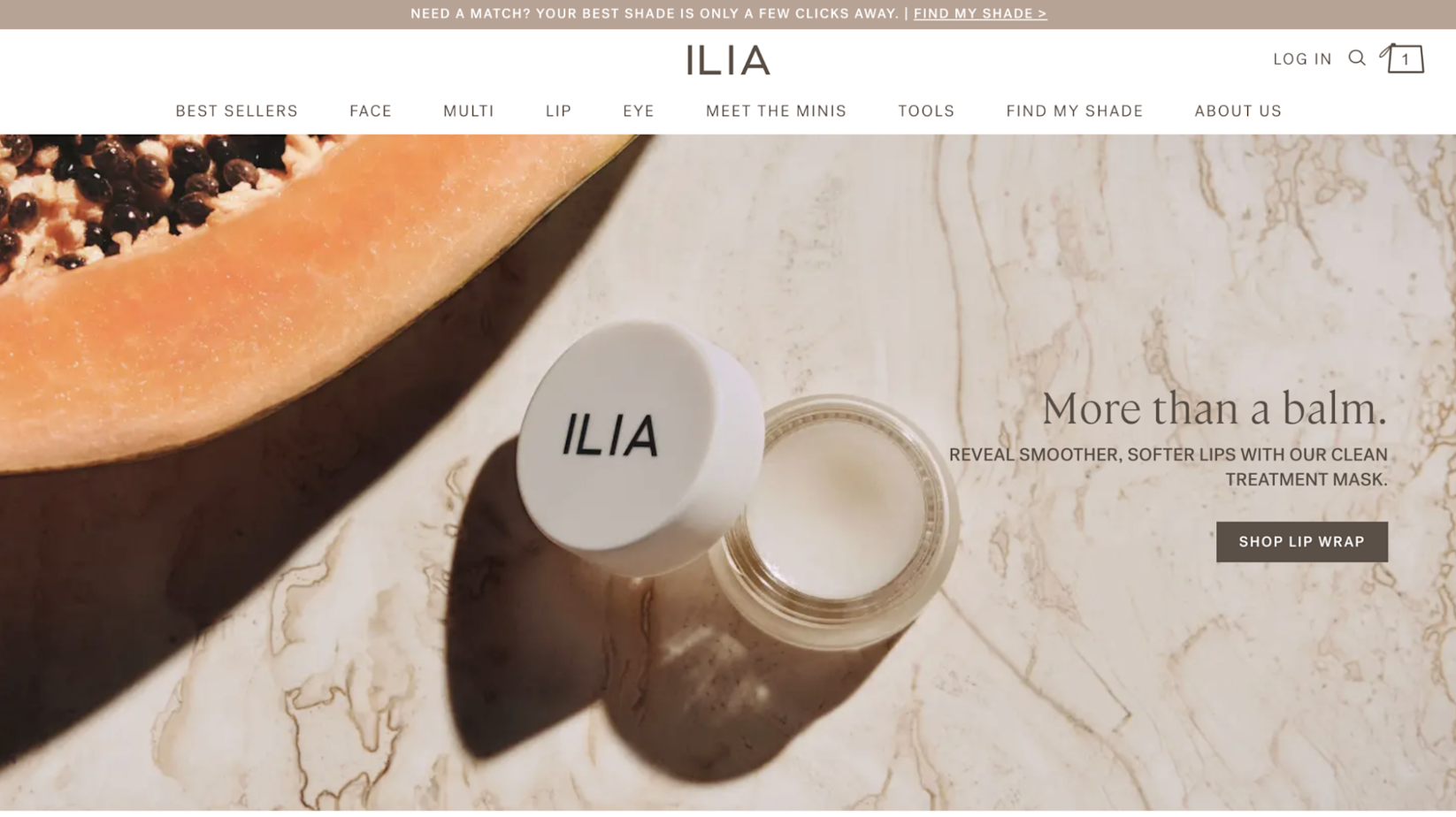
Its online shopping experience takes into account the fact you can’t try out a lipstick color in real life. That’s what the “Compare shades” option is for:
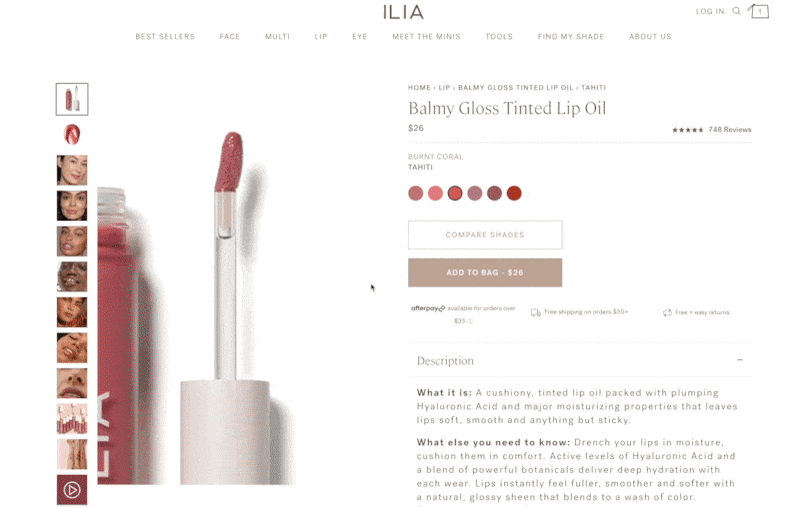
Choosing a foundation shade is no different. There’s an extra option here: uploading a selfie to get help from a brand specialist.

This experience works seamlessly for Instagram shoppers, too:
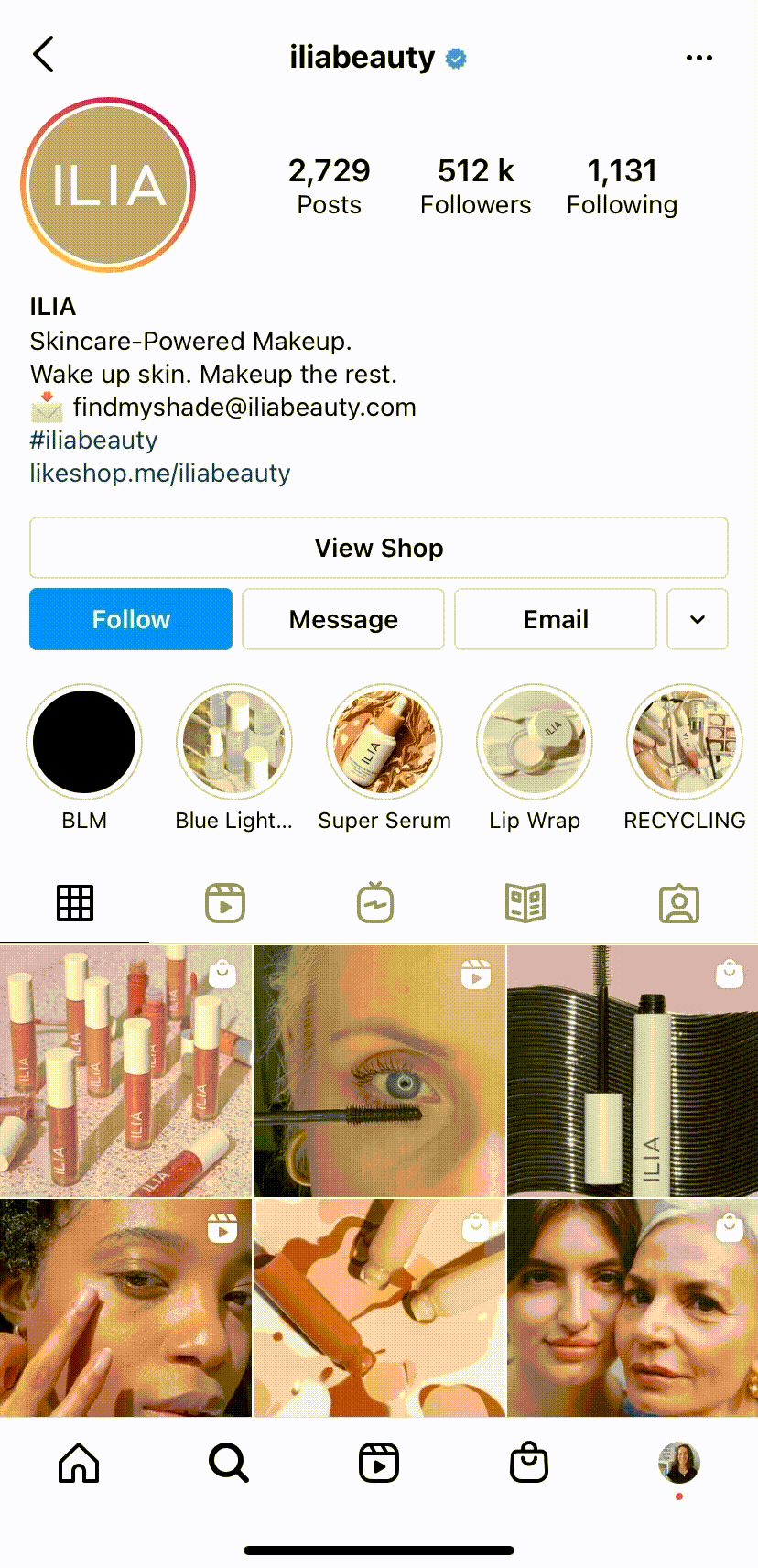
Wherever customers shop from, they can go through express checkout withShop Payor PayPal.
大流行改变了消费者对美容商店, too. Sarah Jindal, associate director for global beauty and personal care at Mintel, said38% of US beauty consumersare more comfortable shopping online than in the past year. Shade comparison and matching is a great way to simplify self-service shopping.
ILIA’s omnichannel efforts also include offline advertising.
In early 2020, ILIA kicked off its first outdoor ad campaign. It included a feature on a Manhattan tour bus, billboards in LA, and wild postings in New York City. These were placed near Credo and Sephora stores.
ILIA wanted to increase national brand awareness. One of the ways it measured success was through social media follower growth. ItsInstagram followerswere at just under 200,000 at the time; about a year later, this number is now over half a million.
“There is a narrative from being able to see a brand as an ad in your phone, then on Instagram, then outside on a billboard and finally in Sephora. It creates a 3D effect,” Sasha Plavsic, ILIA’s founder and creative director, toldGlossy。
Cocomelody
Cocomelodysells affordable wedding dresses, bridesmaid dresses, and formal dresses.
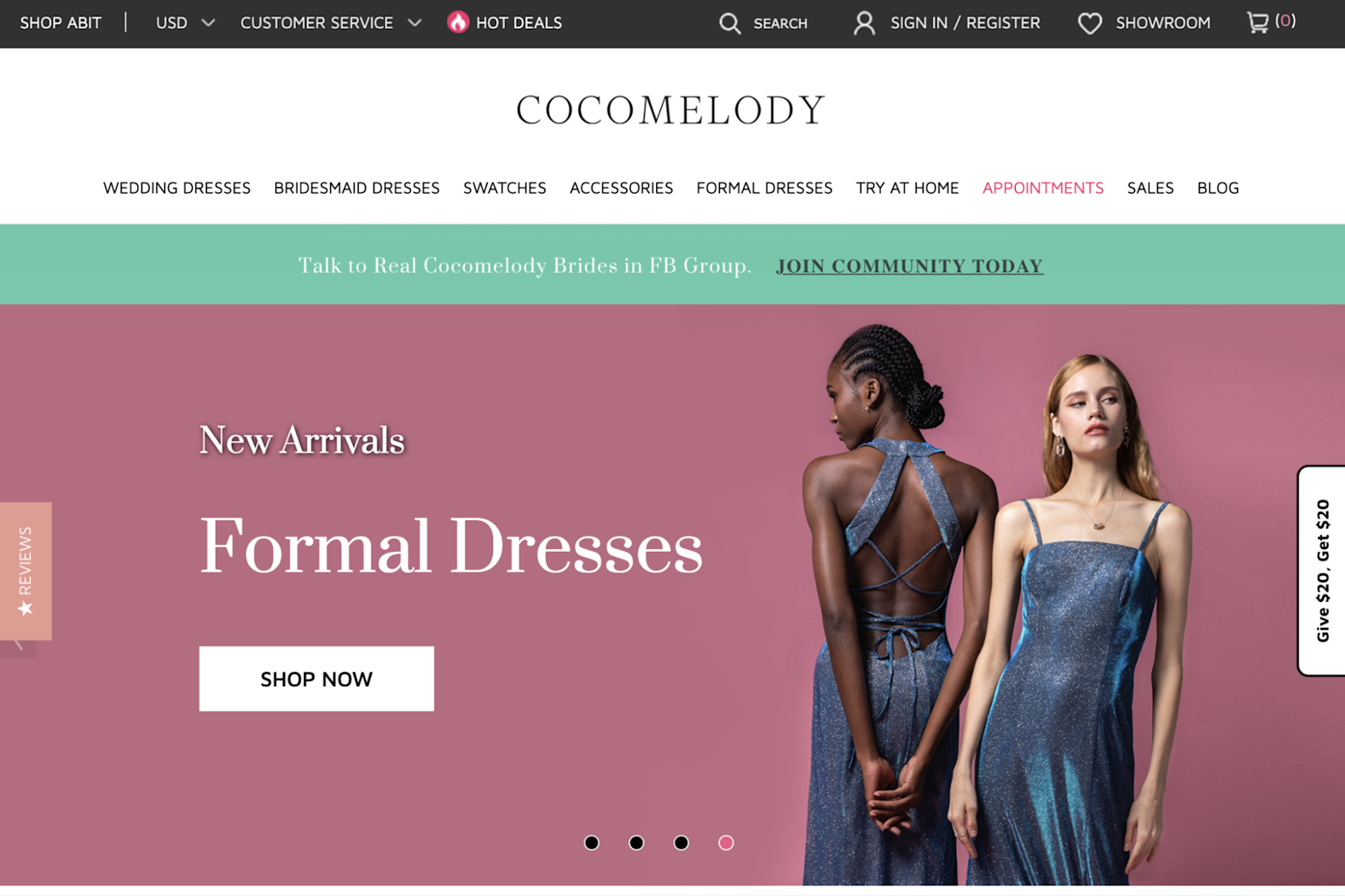
Its marketing team used Google Ads and sponsored Facebook posts to drive engagement with its target audience. Butit struggledto keep these users around, and its ad conversion rates were stagnant.
Once it looked at the data more holistically, it saw a high cart abandonment rate, but also that these users came back to the site often. Cocomelody’s customers were interested, but struggling: they couldn’t touch or try on these dresses.
The solution:home try onfor just $25 per dress, plus easy returns, andfabric swatchdelivery.
Cocomelody then targeted cart abandoners to let them know of these new options, including push notifications, SMS messages, and personalized emails. This increased sales by 30%.
Other assets Cocomelody built to provide a seamless customer experience includecolor charts, aFacebook groupwith more than 35,000 members,fit guides, and measurement guides.
Take your next omnichannel experience step
你的行动是什么项目run an omnichannel brand? If you’re already focused onomnichannel marketingand shopping, it might be to polish your customer service or inventory management.
Learn more:[Omnichannel Marketing Guide] What is It and How to Get Started
And if you’re starting to bring your different channels together, you might start with understanding your audience better and finding gaps in the options you give them on different channels.
